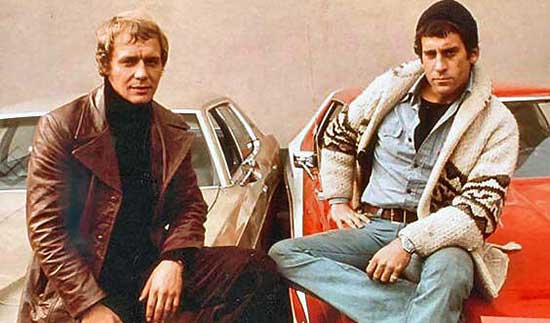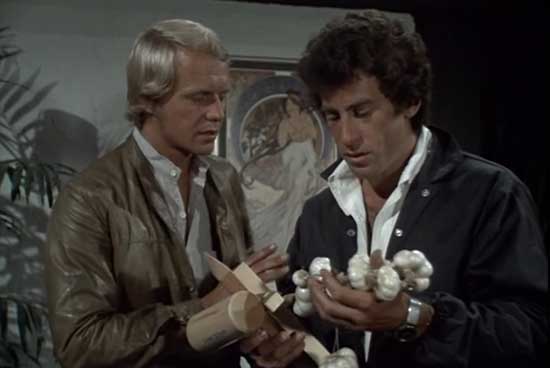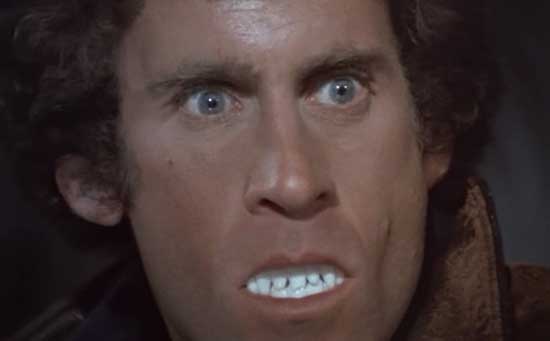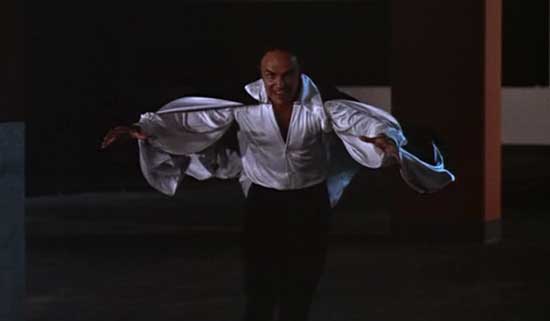When “Dracula” appeared on Starsky & Hutch, the episode was a prime time television event. No, the villain that guest star John Saxon played wasn’t Dracula, but the episode still ranked as eventful. The series’ one and only Halloween special further contributes to the program’s cult following and remains memorable among fans of 1970s pop culture.
Just as Carl Kolchak once mused about a vampire loose in Las Vegas, “try and tell yourself…it couldn’t happen here,” try and tell yourself a modern cop show could feature an off-the-wall horror episode and now maintains a cult following 44 years after the first airing. If done today, could a contemporary police melodrama present a horror-themed show and deliver a similar impact? Doubtful, as the “here” and “now” of the television industry changed immensely since the mid-1970s.
Those legendary bygone television days were different, and a lot of fun.
A Television Landscape Older than Dracula
Younger fans could never fathom the archaic television viewing presentations of the pre-digital age. Major markets usually only had three network channels, maybe three UHF channels, PBS, and, perhaps, the additional snowy reception of a UHF channel from a town many miles away. Some locations did have cable TV, but the cable universe was relatively minute. And mostly the wealthy and the indebted owned a VCR or Betamax machine.
Viewers found themselves “compelled” to watch a show live as it broadcast, and the networks competed fiercely with each other for audiences. Once the show found an audience, it stuck with a formula to keep them. To make things special, a top show would run a holiday-themed episode. If it were a hit, the episode would appear in the future seasons as a special repeat and an extra evening of advertising dollars. Halloween-themed episodes often ranked high among audiences since they offered a chance to watch original horror-themed, both scary or comedic. Sometimes both.
Starsky & Hutch might have produced one of the most popular of all Halloween-themed episodes. Blandly titled “The Vampire,” the episode first aired, appropriately, on October 30, 1976. The over-the-top episode raised eyebrows and might be the most well-remembered of all the Starsky & Hutch stories. Yes, there were better and more dramatic episodes. “The Vampire” was so off-the-wall it continues to demand attention. And the horror genre connection supports the show’s cult following.
The show initially developed a loyal following based on a unique stylistic approach. Starsky & Hutch stood out from the other offerings from the 1970’s loaded lineup of TV cops and private detectives. ( Interestingly, Dennis Weaver’s McCloud featured a somewhat similar gimmick, as the detective met a Dracula-impersonator played by John Carradine) John Saxon’s stirring portrait of Dracula-in-all-but-name drew scores of viewers, despite being so weirdly out of place for the show.
Network execs and producers might have had an “ulterior motive” for green-lighting such an oddball episode. Not everyone wanted to watch a hip and offbeat cop show like Starsky & Hutch, but they may dig old-time horror. An episode like “The Vampire” could attract curiosity seekers. Maybe some would remain regular viewers after watching the horror-themed episode.
And old-time horror creatures still had their fans in 1976.
Traditional Monsters and a Long-Ago TV Landscape
Monsters and Halloween specials worked because audiences enjoyed them. They also allowed the network to repeat the holiday episode in future seasons, delivering an extra episode and added advertising dollars.
Classic monsters were still a thing back in the 1970s, as Saturday afternoon and evening reruns of classic horror movies featuring Frankenstein, The Wolfman, The Mummy, and, of course, Count Dracula ingrained in the public consciousness. People weren’t too interested in paying to see the old-time monsters at the cinema, though. With the right approach, they could still grab audiences on television.
Night of the Living Dead (1968), The Exorcist(1973), The Texas Chainsaw Massacre (1974), and Halloween (1978) did their part to move classic monsters out to pasture. On television, however, classic monsters could grab kids and older viewers interested in nostalgia. Classic monsters had another benefit – they allowed primetime television to tap the horror genre for ideas without offending sensibilities. Traditional monsters seemed harmless enough that Standards & Practices executives didn’t have fits over them. Such was not the case when trying to write repeatedly rejected “slasher-style” scripts for the show that eventually morphed into the brilliant anthology Darkroom (1981).
Halloween provided the perfect time to bring these monsters out of mothballs, although some programs Interestingly, Hart to Hart saw a mummy appear during the first week of January. Perhaps that was the way they wanted to ring in the New Year back in 1981. A holdover from the 1970s story ideas, the weird episode was one of the final out-of-place monster-themed network TV episodes of the era.
Starsky & Hutch came at the right time and worked.
Starsky & Hutch:That 1970s Cop Show Take a Sidestep to Horror
Even during the 1970s heyday of classic monsters on TV shows and television movies, a vampire’s appearance on the David Soul and Paul Michael Glaser program seemed odd. And yet, the episode hit an All Hallow’s Eve home run and continues to endear. Maybe oddness worked with Starsky & Hutch because, well, many found the show quite atypical for a cop drama.
Starsky & Hutch was different. The series represented a new age of quirky and hip television cop shows. By focusing on two young and cool cops, the series presented a sharp contrast to the old-school approach. In some ways, Starsky & Hutch presented a swinging 70’s version of the more straightlaced series Adam 12 or The Rookies. Me Decade cop shows such as Police Woman, SWAT, and others breathe fresh life into police dramas. Starsky & Hutch took things a little further.
Starsky & Hutch was also a little oddball considering the quirky humor it’s star characters presented. The show is not so over the top that it became ridiculous, but the odd nature ensured the vampire episode did not as ridiculous as it could have. Dracula wouldn’t be an appropriate villain in Kojak. A vampire makes a great villain on Starsky & Hutch.
Here’s how it plays out.
Investigating “The Vampire”
Did a vampire just murder a woman on a dark city street? The opening minutes of the episode indicates, yes.
Jump to a disco bar where the two title detectives try to pick up two single women, a sequence well at home during the decidedly un-P.C. mid-1970s entertainment era. Besides infusing levity to calm viewers after the violent opening, the scene appears to establish the characters. Starsky is goofy, and Hutch is cool. They have the odd bromance thing going, 40 years before the term came into existence. The network clearly expected the Halloween special to bring some new viewers and wanted to get the characters’ personalities across.
Viewers learn that swinging bachelors Kenneth “Hutch” Hutchinson and David Starksy may both turn serious when duty calls. A stripper named Honey Williams was murdered and drained of blood. Starsky and Hutch start handling detective work to find out who killed her, although the audience already knows. Dance instructor Rene Nadasy strangled her and then chewed her throat to drain her blood all while dressed in full vampire garb. (“What kind of weirdo are we dealing with here?”)
The two detectives follow a lead to a dance studio run by Nadasy, who notes, “The world is becoming an unsafe place to live.” For young women dancers, the sentiment is garishly accurate. Williams turns out to be the second victim killed the same way, leading Starsky to ask his partner, “You ever see any of those vampire movies?” Hutch responds casually, “That’s good, Starsky.” (Pats him on the shoulder) “That’s a very sensible conclusion.” The comment doesn’t rattle Hutch too much, as he’s familiar with his partner’s own personal weirdness. Besides, Hutch gets busy calling other police departments asking about criminals known for their “Blood fetishes.”
Starsky has a feeling the perpetrator is a vampire. He’s not entirely wrong. Nadasy believes his satanic vampire powers will allow him to raise his recently deceased wife from the grave. (We’ve seen variations of that plot device in horror movies many times before) Casting counts when trying to make the ridiculous plausible. John Saxon truly is truly creepy in the murderous role, creepy to the point of convincing. He comes off as someone so “not right” we believe he’d become a vampire and attempt to make his blood serum strategy work. And the plan leads him to murder more young dancers.
The duo comes across a murder scene moments late, but Hutch chases a man in a cape up the stairs and onto the rooftop. Hutch never gets a good look at the cape-wearing Nadasy, so he can’t identify him. Hutch does see Nadasy leap to another rooftop and escape, a rooftop 25 feet away. And Hutch feels convinced, “He flew.”
The chase scene is a great one because it establishes some belief in Hutch’s mind that maybe there is something to the vampire theory. The escape adds some questions to the viewers’ minds. We’ve seen Nadasy walking around in sunlight, but could he still be a real vampire?
The detectives start wondering if there’s something strange about Nadasy, as his students keep getting strangled and drained of blood. He’s worth investigating. (“You two could add a new dimension to the word boorish.”)
The detectives gradually piece several facts together and know they need to play another visit to Nadasy’s playhouse. Don’t think The Vampire makes it easy for them.
As a teleplay, “The Vampire” moves briskly from its brutal opening scene to its obvious-stunt-double-action-packed finale. The mix of horror, humor, and action adds up to an hour’s worth of entertaining television. Yes, it is hokey by today’s standards, and that’s part of the charm.
The series also benefits by having the perfect director at the helm.
The Return of Bob Kelljan
Genre fans may recognize the name Bob Kelljan when they see the director credit. Kelljan represented a great choice to helm this episode, as he previously scored hits as the director of the modern-day vampire films Count Yorga, Vampire (1970), The Return of Count Yorga (1971), and the outstanding Scream, Blacula Scream (1973). Kelljan’s influence on the episode becomes obvious when Nadasy runs towards his victims. Eerie and menacing “running vampires” are somewhat unique to Kelljan’s works. Most cinematic vampires moved more than a bit slow. Then again, Kelljan would sometimes film his running vampires in slow motion, as seen in Count Yorga, Vampire.
Kelljan already had an in with the series. He directed eight episodes of Starsky & Hutch, along with many other popular 1970s cop/action shows. He lent his talents to Wonder Woman, Police Story, Vega$, and Charlie’s Angels. “The Vampire” was not his debut for Starsky & Hutch, though. He directed two episodes in 1975.
Had Kelljan not been part of the Starsky & Hutch team, would “The Vampire” existed? You have to think someone came up with the idea about a vampire-themed Halloween episode after looking at Kelljan’s resume. Or maybe Kelljan had something directly to do with the idea. So far, there doesn’t appear to be much reference material about who came up with the plot. It does seem coincidental that the series opted to go with a vampire villain after hiring the director of three well-made vampire films.
The Legacy of “The Vampire”
Available on DVD and streaming, Starsky & Hutch saw repeats on the El Rey Network and Cosi TV. The Roku Channel airs it, and iTunes, Prime, and other sites offer download options. The current enthusiasm for the show pales compared to its glory days on network TV and early syndication, to put it mildly. Of course, the series was still fresh in people’s minds in 1980. A fan could say the same of many 1970s programs that thrived in syndication in the 1980s. A few series did continue to thrive far beyond.
The 1970s produced a great deal of incredible television, with the vastly expanded cable universe, programs that long ago disappeared from television air once again. The audiences, however, aren’t likely too big. Many shows provide filler programming for various B and C-level channels. While it is great to see an old classic program back, how many people tune in at 3 AM?
If it is a horror or sci-fi show, the numbers may be better than expected. Those fans like to seek things out. Speculating how many horror fans seek out and watch “The Vampire” would be exactly that – pure speculation. Horror fans are completists, and many probably would check the show out for nostalgia’s sake. Younger fans who want to see something they never watched before may give it a look.
What is the episode’s legacy? “The Vampire” stands as an intriguing, offbeat episode from a once iconic TV series. While it might not lead many horror fans to check out every episode of Starsky & Hutch, some may feel inclined to watch this one. And Starsky & Hutch may live forever.
 Horror News | HNN Official Site | Horror Movies,Trailers, Reviews
Horror News | HNN Official Site | Horror Movies,Trailers, Reviews





That image of John Saxon in the cape belongs on a t-shirt!
great episode! when I met John Saxon I told him scared me in that role. He reenacted the run for me! great guy.